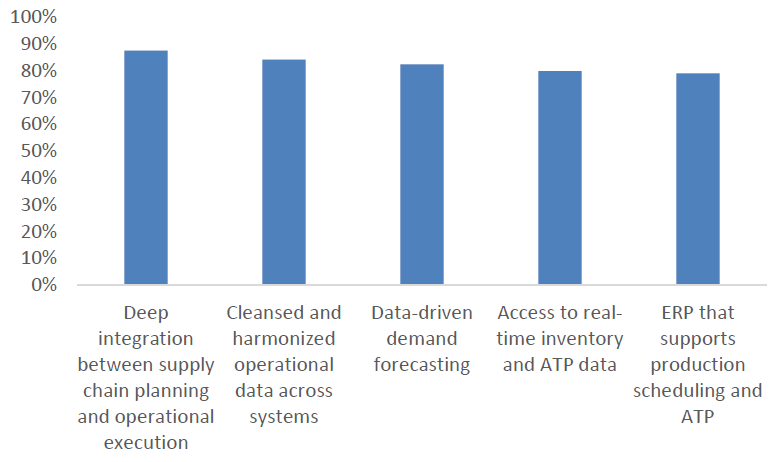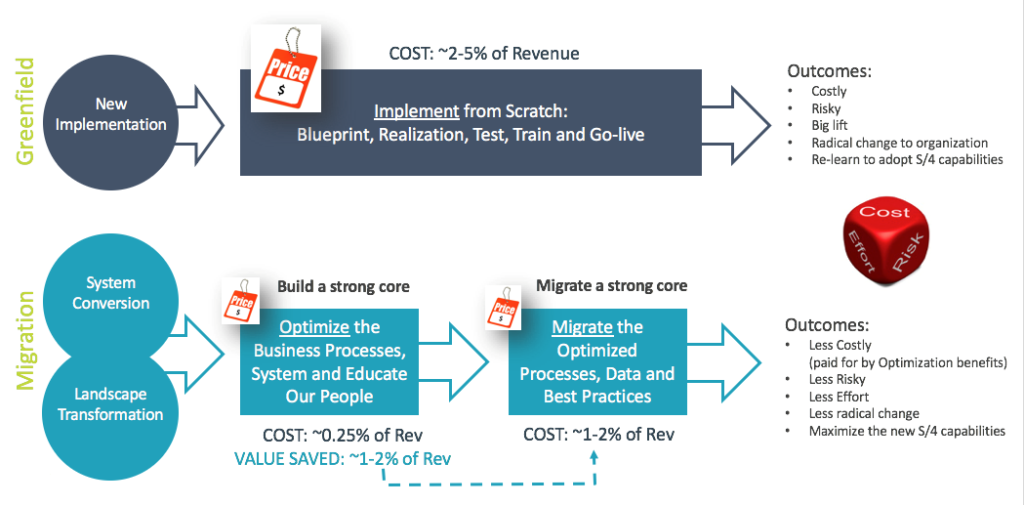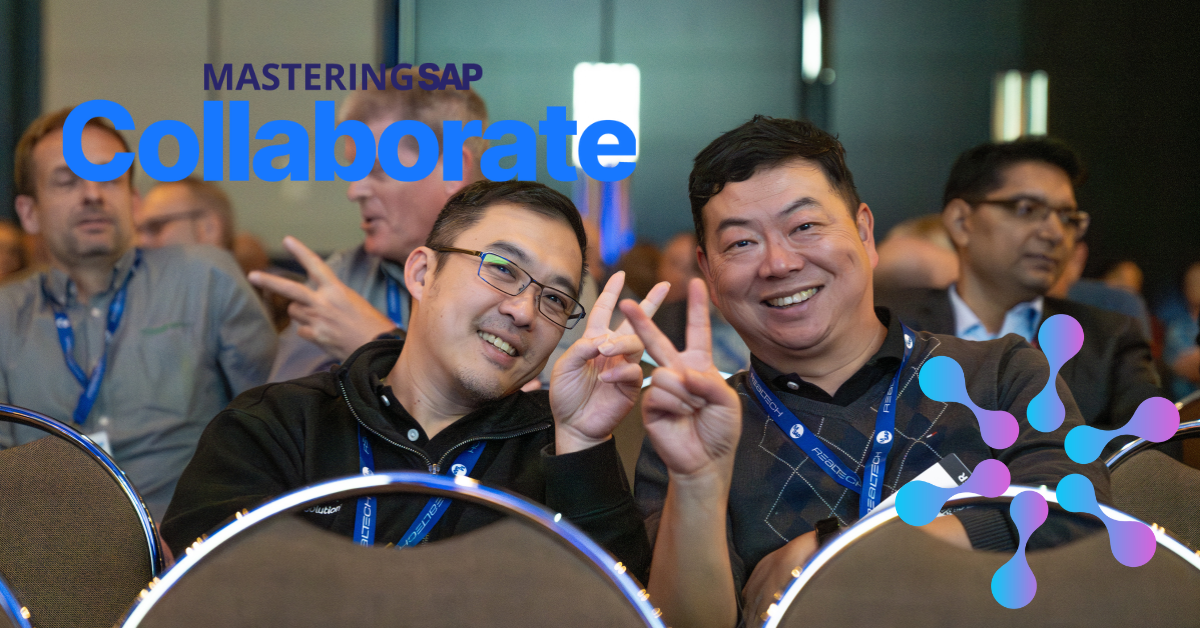An Executive’s Guide to Self-funding an SAP S/4HANA Migration
Meet the Experts
By Martin Rowan, Managing Partner, Reveal
Making the Case for Transformation with SAP S/4HANA
In SAP’s presentation “Building an Intelligent Enterprise Strategy” the company cites a 527% improvement in customer profit margin year-over-year for companies with a best-in-class customer experience. The same SAP study reveals a 202% better business performance than peers when companies have engaged employees. While these results are formidable and compelling, they are all grounded on one key factor: the data—the fuel that drives performance of the supply chain—must be trustworthy. As companies aggressively seek solutions for the supply chain “new normal” — shortages, demand spikes, order sizes of one, next-day (next-hour) delivery expectations, last mile track and trace, increased competition—trustworthy data combined with an educated workforce and a higher level of critical thinking is essential.
When it comes to SAP, all roads lead to SAP S/4HANA by 2027, but not all paths are equally cost-effective and trouble-free. As you prepare for the upcoming migration, you may already be falling victim to an overly optimistic thought process:
Explore related questions
“This time will be different. This time, we’ll stick to our business rules and standards, set up our master data correctly, and fully educate and train our people. This time, we’ll know Precisely how to best leverage the system and drive profitability and increased share of market.”
There’s just one problem with that kind of thinking. For most organizations, it doesn’t happen. At Reveal, our experience tells us that most companies focus on a technical implementation, which ensures that the system is technically humming along and performing as expected. But that’s not nearly enough. In reality, a company’s focus should be on a fully integrated functional transformation, where SAP S/4HANA is set up optimally to maximize the performance of both people and processes. To execute a functional transformation, you need a clear understanding of how your SAP system works. Put simply, you can’t prepare for a major transformation process by placing a few band-aids on untrustworthy data or sub-optimal performance. It’s impossible to not address your current challenges and still expect to gain maximum benefits from an all-new, from-scratch implementation. Before you hit the reset button and move into the accelerated world of SAP S/4HANA, you must leverage the SAP tools you currently use to their fullest capacities. Only in that way will you realize immediate value from your new technology investment.
Doing so requires effort, commitment and a clear understanding of the opportunities and challenges that will present themselves with the SAP S/4HANA migration. The time to get your house in order is now, so you can fully take advantage of the amazing digital transformation possibilities that await you. As noted in the recent SAPinsider benchmark report, Modernizing Supply Chain and Operations, 2020, the top requirements for supply chain planning and operations are illustrated in Figure 1.

Figure 1— Top requirements for supply chain planning and operations
Moving to SAP S/4HANA Is Strategic—But So Is the Path You Choose to Get There
It’s a given that any organization aiming for best-of-class status must move as seamlessly and efficiently as possible to SAP S/4HANA. But to determine your path forward, you must ask yourself some crucial questions:
- Is our organization mature enough to migrate?
- Do we need to go back to basics and prepare the organization for the major change?
- Is our data trustworthy in real time?
- Does our master data reflect the reality of our business rules?
- Are we serving our shop floor on time and in full and is the shop floor increasing schedule attainment to meet customer expectations?
- Are we closing month-ends expeditiously or do we have excessive manual journal entries and reconciliations to do every month?
- Are we working hard or letting the system do the hard work, meaning are we using spreadsheets to make decisions; manually intervening on every transactions; reconciling at every turn; optimizing how we’re buying; maximizing work center capacity?
Most organizations struggle with these questions. At Reveal our experience tells us that on average, companies utilize less than 25% of SAP’s integrated capabilities. They attempt to implement different sources of truth—pulling information out of SAP into siloed spreadsheets, running manual and disparate planning systems, and then reactively telling SAP what they did. Or they find themselves constantly firefighting instead of managing by exception—acting rapidly and decisively to identify and fix incorrect rules or processes, behaviors that do not match rules, or bad data. Sadly, in our experience, less than one company out of every 10 even understands what exceptions are, let alone manage by exception.
Due to a lack of business-wide ownership of SAP usage and exploitation, an inability to align behavior with business rules, and lack of ongoing employee education (many companies provide less than two weeks of training), organizations don’t recognize their expected return investment after going live. They inadvertently make decisions that result in a substantial drain in profitability due to building organization buffers (headcount, lead times, etc.) as well as inventory and manual workarounds. Ultimately, the lack of commitment to an investment in an educated, knowledgeable workforce can cost the organization five times as much as they continue to support undertrained employees.
ALL THIS BRINGS US TO THE HARD TRUTH: unless you trust your data, establish business ownership of the master data (business rules), ensure functional integration and educate your people, you are probably not in a position to implement SAP S/4HANA from scratch. The most common route to SAP S/4HANA is taking a Greenfield approach. At first glance, the Greenfield approach may sound enticing—a true reset for your SAP processes with an all-new system configuration and implementation of SAP S/4HANA. But look a little closer. By committing to the Greenfield approach, your current business will go into limbo for months or even years as you design the “new” processes. You must also anticipate major change and disruption to the business as you commit a large number of people to the project. All existing system customizations or more likely to be redeveloped, leading to astronomical reimplementation costs.
If that sounds like one giant headache—it is. By implementing from scratch, you take your poor habits, lack of data ownership, and bad practices directly to SAP S/4HANA. The result is precisely what you might expect: ACCELERATED CHAOS with limited benefits and an inability to maximize the value of SAP S/4HANA. Yet many organizations automatically opt for this “from scratch” approach, believing that “this time it will be different” as if they suddenly are working from a fresh slate with re-engineered processes and reduced customization. Actually, the exact opposite usually occurs.
Think of it this way: you don’t want to drag bad data, bad processes and bad behavior into your new environment. It would be like buying a high-end sports car and then filling it with bad fuel, keeping it consistently in first gear, and giving the keys to someone who never went through driver’s education. What kind of performance could you expect with that combination? There has to be a better way to supercharge outcomes—and there is.
Now, what if your company was able to:
- Optimize and maximize business processes and functional integration.
- Strengthen the value of its people through education and understanding.
- Establish trustworthy data and improved decision making.
- See benefits such as:
- Improved inventory turns by at least 17%
- Operational efficiencies increased by at least 5%
- Reduction in purchasing spend by at least 2-3%
- Increased end to end service levels by at least 20%
- Take the savings from maturing and optimizing the business processes and practices (usually around 1-2% of revenue) and use it to self-fund your migration to S/4HANA.
The result of accomplishing the objectives listed in the bullets above is achieving the best possible outcome: less risk, less effort and less radical change at the most cost-effective approach.
If that sounds compelling, your organization should consider the Optimized Brownfield approach, which consists of a migration of your current SAP ECC system into an SAP S/4HANA one. With an Optimized Brownfield approach, you can preserve the investments you made in your current SAP ECC solution, save your historical data, and rapidly convert improved and optimized business processes/practices and master data to SAP S/4HANA. Then you can gradually adopt the digital transformation innovations and functionality that SAP S/4HANA provides at your own pace.
The Optimized Brownfield approach offers all kinds of benefits including less risk, less radical change, no reimplementation with ensuing disruption to existing business practices, and the ability to gradually reevaluate customization and existing flows. One of its most attractive benefits is that it is self-funding. You save money by first increasing your Business Maturity®, optimizing the business processes, educating the users and managers, and increasing data integrity. (Learn about the Business Maturity principle during my session at SAPinsider’s Supply Chain Virtual Summit November 17-18, 2020.) And that money can go into combining SAP S/4HANA with an overall consolidation and harmonization of your current SAP-related business processes.
Your Successful Digital Future Will Hinge on the Path You Decide To Pursue
Now that you have the facts, which path will you choose? You can choose the Greenfield path, hoping to re-learn to adopt SAP S/4HANA capabilities and this time, get it right. If you choose Greenfield, you can expect to spend up to 5% of your annual revenue on your total ERP (software, hardware, consulting, internal human capital) and digital transformation initiative. By migrating unoptimized processes, this major investment will likely not pay off.
Or you can take the Optimized Brownfield or Orangefield path, building a strong core by optimizing the data, processes, and capabilities of your people. Strengthening your core through optimization will reduce operating costs and likely free up working capital. The average savings translates to 1-2% of revenue. When you take these savings and apply them to your migration (1-3% of revenue), you have a self-funding model to move to SAP S/4HANA (Figure 2).

Figure 2—Comparison between Greenfield and Migration (Optimized Brownfield)
For many companies, it makes little sense to move forward to SAP S/4HANA on a wing and a prayer, struggling to leverage the technology to achieve business value with the Greenfield approach. Chances are, your SAP functionality will remain under-utilized, you’ll retain a lack of strategic and tactical visibility to crucial data, your people will attempt to solve problems with limited training and no true education, and your key processes will continue to be siloed. The result is the same-old, same-old: your users will grow frustrated, your inventory costs and operation costs will rise, and your system will become difficult to manage.
Or you can make a promise that this time will truly be different. This time, you’ll build a strong core by optimizing processes, data, and smart use of SAP for savings and profitability that have never before been realized. You owe it to yourself to explore the pitfalls of the various options and to forge your own clear path by optimizing NOW to help fund a migration to SAP S/4HANA. Nothing less than the future of your digital transformation is at stake.
Hear more about how to self-fund a migration to SAP S/4HANA during my session at SAPinsider’s Supply Chain Virtual Summit, November 17-18, “Post-COVID: Lessons learned from the crisis and how our supply chains need to change.”






